Problem : Solution Fix accidental silhouettes Problem: Objects in the foreground of an image appear silhouetted. 
Solution: Adjust the tonal values of your image to bring a dark foreground into the light with some help from a mask. 
| Have you ever taken a picture directly in front of a window? If you have, and you didn't use either a flash or a fill-flash to reduce the lighting ratios, then your final print was probably less than desirable. Due to strong lighting and very dark shadows, anything located in front of the window will be silhouetted. Happily, Photoshop offers the tools you need to lighten things up. |
Making a negative 1. | Open an image that you want to retouch in Photoshop.
| 2. | Make a separate copy of the image by choosing Image  Duplicate. The Duplicate Image dialog box opens. Duplicate. The Duplicate Image dialog box opens.
| 3. | Name your new document Negative and click OK.
| 4. | Choose Image  Mode Mode  Grayscale to change the mode to Grayscale. If, at this point, the Adobe Photoshop dialog box displays, asking you to discard color information, click OK. Grayscale to change the mode to Grayscale. If, at this point, the Adobe Photoshop dialog box displays, asking you to discard color information, click OK.
| 5. | Choose Image  Adjustments Adjustments  Invert to create a negative image. Invert to create a negative image.
| 6. | Choose Filter  Blur Blur  Gaussian Blur to soften the edges of your image. Set the Radius of your blur to 5 pixels and click OK. Gaussian Blur to soften the edges of your image. Set the Radius of your blur to 5 pixels and click OK.
| 7. | Save your final Negative document as a PSD file, but don't close the document. We're now ready to apply this image to our original in order to define the areas we need to add light to.
| 8. | Click on your original file to make it active.
|
Loading your selection To apply your Negative image to your original, you have to load the selection. 1. | Choose Select  Load Selection. The Load Selection dialog box displays. Load Selection. The Load Selection dialog box displays.
| 2. | Select Negative.psd from the Document dropdown list.
| 3. | Make sure Gray is selected from the Channel dropdown list and the New Selection option button is selected as well.
| 4. | Click OK. The dark areas of your image should now be selected.
|
Lighting shadows 1. | Keep your selection active and copy the dark portions of your image onto a new layer by choosing Layer  New New  Layer Via Copy. Layer Via Copy.
| 2. | Name this layer Light.
| 3. | Choose Edit  Fill to display the Fill dialog box. Fill to display the Fill dialog box.
| 4. | Select 50% Gray from the Use dropdown list and select Color Dodge from the Mode dropdown list. Leave the Opacity of your fill at 100% and select the Preserve Transparency check box, which will prevent your fill from affecting any areas of the layer that are transparent.
| 5. | Click OK. At this point, your image should look much lighter.
|
Adding the final touches Although your image is looking much better, it still may need additional retouching. For example, some areas of your image may be too washed out and others may still be too dark. However, with a little fine-tuning you can remedy this. Let's see how. Darkening your image Perhaps the background of your image was lightened too much. To correct overly brightened areas: 1. | Click the Add Layer Mask button  on the Layers palette to add a mask to your Light layer. on the Layers palette to add a mask to your Light layer.
| 2. | Using a soft round brush, with the Set Foreground Color swatch set to black, paint out the portions of your image that you want darker. For more subtle results, try painting your mask using gray. If you want to darken the entire image, just lower the Opacity of the Light layer on the Layers palette.
|
Lightening your image If you want to lighten portions of your image even more: 1. | Make a copy of your Light layer in the Layers palette.
| 2. | Mask out any areas that are too light. For more focused retouching, save a flattened copy of your retouched image. Then, using the Dodge tool  with a low Exposure, paint directly over areas that need to be lightened. with a low Exposure, paint directly over areas that need to be lightened.
|
Putting it to the test Besides working wonderfully on pictures taken directly in front of a window, this technique is great for retouching any image with a lot of contrast. Also, try modifying the technique a bit so you can use it to adjust the light and dark values in all of your images. |


 Duplicate. The Duplicate Image dialog box opens.
Duplicate. The Duplicate Image dialog box opens. Grayscale to change the mode to Grayscale. If, at this point, the Adobe Photoshop dialog box displays, asking you to discard color information, click OK.
Grayscale to change the mode to Grayscale. If, at this point, the Adobe Photoshop dialog box displays, asking you to discard color information, click OK.